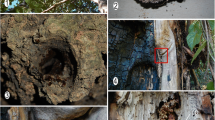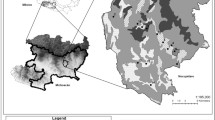Abstract
Here we highlight two ontologically different modes of care and management of endemic stingless bees in Australia. While Indigenous Yolngu and backyard beekeepers both engage in caring for stingless bees, neither way of living with bees would classically be defined as ‘domestication’, yet bees are encompassed within the ‘home’, or domus. This requires a different perspective in relation to the kinds of multispecies connections between humans and other beings. We propose that the key difference between Aboriginal Australians hunting for sugarbag on country and beekeeping in the backyard is in the way bee populations are maintained and in the degree of ecological separation from the surrounding environment. For Yolngu the domus is the bush. Backyard beekeeping involves modes of care that separate bees from outside predators, pests and other detrimental elements, while the Yolngu relationship with bees is primarily concerned with maintaining the integrity of the surrounding ecology, or the homeland.
Similar content being viewed by others
Notes
There is literature positing that the Mayans ‘semi-domesticated’ stingless bees prior to the arrival of the Spanish (Crane 1999).
According to Encyclopaedia Britannica’s ecological definition, the ‘home range’ of an animal is the spatial area where it spends its time; it is the region that encompasses all the resources the animal requires to survive and reproduce (http://www.britannica.com/science/home-range, accessed 27 June 2017).
Tim Ingold makes a distinction between a house and a home, whereby the physical structure itself is the house (or nest), while the setting it is within, where individuals dwell is the home (Ingold 2000, p. 185).
In the past in relation to Yolngu, anthropologists generally referred to clans as the relatives on the male (patrilineal) line, while women were members of neighbouring clans with each individual tied to both their father’s or mother’s country (see Keen 1995). An individual can, therefore, be attached to more than one kind of country.
It was only later that I realised that this kind of ancestral knowledge is not explained but learnt through observation and participation within ceremony, or through narrative accompanying bark paintings.
In 1974 Ian Dunlop, with accompanying film crew, filmed this ceremony in Djungguwan at Gurka’wuy (1989).
This survey suggests that the increase in numbers of backyard beekeepers may be more than the increase in respondents, as only twenty-eight of the respondents within the second survey reported having participated in the first survey.
In conservation circles this means of dispersal is still seen as problematic in that cadaghi is now spreading beyond its historic range, shading forest understories and altering forest compositions.
References
Alberti, M., Marzluff, J., and Hunt, V. M. (2017). Urban driven phenotypic changes: empirical observations and theoretical implications for eco-evolutionary feedback. Phil. Trans. R. Soc. B 372(1712): 1–9.
Baynes-Rock, M. (2015). Among the Bone Eaters: Encounters with Hyenas in Harar (Vol. 8) Penn State Press, Pennsylvania.
Berndt, C. H. (1970). Monsoon and honey wind. In Pouillon, J., and Marandu, P. (eds.), Echanges et Communications. Mélanges offerts à Claude Lévi-Strauss Vol. 2, Mouton, La Hague, pp. 1306–1326.
Burarrwanga, L., Ganambarr, R., Ganambarr-Stubbs, M., Ganambarr, B., Maymuru, D., Wright, S., Suchet-Pearson, S., and Lloyd, K. (2013). Welcome to My Country, Allen & Unwin, Sydney.
Crane, E. (1999). The World History of Beekeeping and Honeyhunting, Routledge, New York.
Dawkins, R. (1976). The Selfish Gene. Oxford University Press, Oxford.
Descola, P. (2013). Beyond Nature and Culture, The University of Chicago Press, Chicago.
Deveson, P., and Dunlop, I. (1997). The Yirrkala Film Project Notes, Unpublished manuscript, AIATSIS, Canberra.
Dunlop, I., and Wanambi, D. (1989). (five-part film) Djungguwan at Gurka’wuy: a film monograph Film Australia, Sydney.
Fijn, N. (2014). Sugarbag Dreaming: the significance of bees to Yolngu in northeast Arnhem Land. Humanimalia 6(1): 41–61.
Fijn, N. (In Press). Dogs Ears and Tails: different relational ways of being in Aboriginal Australia and Mongolia. In Swanson, H., Lien, M., and Ween, G. (eds.), Decentering Domestication, Duke University Press, Durham.
Gloag, R., Heard, T. A., Beekman, M., and Oldroyd, B. P. (2008). Nest defence in a stingless bee: What causes fighting swarms in Trigona carbonaria (Hymenoptera, Meliponini)? Insectes Sociaux 55(4): 387–391.
Greco, M. K., Hoffmann, D., Dollin, A., Duncan, M., Spooner-Hart, R., and Neumann, P. (2010). The alternative Pharaoh approach: stingless bees mummify beetle parasites alive. Naturwissenschaften 97(3): 319–323.
Halcroft, M., Spooner-Hart, R., and Dollin, L. A. (2013a). Australian stingless bees. In Vit, P., Pedro, S. R. M., and Roubik, D. (eds.), Pot-Honey, Springer, New York, pp. 35–72.
Halcroft, M. T., Spooner-Hart, R., Haigh, A. M., Heard, T. A., and Dollin, A. (2013b). The Australian stingless bee industry: a follow-up survey, one decade on. Journal of Apicultural Research 52(2): 1–7.
Heard, T. (2015). The Australian Stingless Bee Book, Sugarbag, Brisbane.
Heard, T. A., and Dollin, A. E. (2000). Stingless bee keeping in Australia: snapshot of an infant industry. Bee World 81(3): 116–125.
Hodder, I. (1993). The Domestication of Europe: structure and contingency in Neolithic societies, Blackwells, Oxford.
Ingold, T. (2000). The Perception of the Environment: perceptions on livelihood, dwelling and skill, Routledge, London & New York.
Jackson, M. (2000). At Home in the World, Duke University Press, Durham & London.
Kaluza, B. F., Wallace, H., Heard, T. A., Klein, A. M., and Leonhardt, S. D. (2016). Urban gardens promote bee foraging over natural habitats and plantations. Ecology and Evolution 6(5): 1304–1316.
Keen, I. (1995). Metaphor and the metalanguage: “groups” in northeast Arnhem Land. American Ethnologist 22(3): 502–527.
Keen, I. (2006). Ancestors, magic, and exchange in Yolngu doctrines: extensions of the person in time and space. Journal of the Royal Anthropological Institute 12: 515–530.
Kritsky, G. (2010). The quest for the perfect hive: A history of innovation in bee culture, Oxford University Press, London.
Lien, M. (2015). Becoming Salmon: aquaculture and the domestication of a fish, University of California Press, California.
Marika, B., Mumyarryun, B., Munyarryun, B., Marawili, N., and Marika, W. (2012). Ranger Djama? Manymak. In Altman, J., and Kerins, S. (eds.), People on Country: vital landscapes, Indigenous futures, The Federation Press, Sydney, pp. 132–135.
Morphy, H. (1977). Too Many Meanings: an analysis of the artistic system of the Yolngu of Northeast Arnhem Land, ANU Press, Canberra.
Morphy, H. (1991). Ancestral Connections: art and an Aboriginal system of knowledge, University of Chicago Press, Chicago.
Myers, F. R. (1986). Pintupi Country, Pintupi Self: sentiment, place, and politics among Western Desert Aborigines, Smithsonian Institution Press, Washington & London.
Plumwood, V. (1993). Feminism and the Mastery of Nature, Routledge, New York.
Rose, D. (1996). Nourishing Terrains: Australian Aboriginal views of landscape and wilderness, Australian Heritage Commission, Canberra.
Rose, D. (2005). An Indigenous Philosophical Ecology: situating the human. The Australian Journal of Anthropology 16(3): 294–305.
Strathern, M. (1980). No nature, no culture: the Hagen case. In MacCormack, C. P. and Strathern, M. (eds.), Nature, Culture and Gender. Cambridge University Press, Cambridge.
Swanson, H., Lien, M., and Ween, G. (In Press). Decentering Domestication, Duke University Press, Durham.
Thomson, D. (1939). The seasonal factor in human culture: illustrated from the life of a contemporary nomadic group. Prehistorical Society Proceedings 5(2): 209–221.
Thomson, D. (1949). Arnhem Land: explorations among an unknown people. Part III. On foot across Arnhem Land. The Geographical Journal 114: 53–67.
Tsing, A. (2015). The Mushroom at the End of the World: on the possibility of life in Capitalist ruins, Princeton University Press, Princeton.
Wallace, H. M., and Trueman, S. J. (1995). Dispersal of Eucalyptus torelliana seeds by the resin-collecting stingless bee, Trigona carbonaria. Oecologia 104(1): 12–16.
Warner, W. L. (1937). A Black Civilization: a social study of an Australian tribe, Harper and Brothers, New York.
Wilkins, A. S., Wrangham, R. W., and Fitch, W. T. (2014). The ‘domestication syndrome’ in mammals: a unified explanation based on neural crest cell behavior and genetics. Genetics 197: 795–808.
Acknowledgements
Author 1 would like to thank the Yirralka Rangers for allowing her to accompany them on ranger activities within homelands across the Layhnapuy Indigenous Protected Area in northeast Arnhem Land. Their stewardship and management is crucial for caring for country. Thank you to Ian Keen for checking Yolngu terms within the manuscript. Author 2 would like to thank Tim Heard for sharing his time and extensive knowledge of stingless bees and beekeeping.
Funding
Author A’s research was funded by the College of Arts and Social Sciences, The Australian National University. Author B’s work was partly supported by the John Templeton Foundation under Grant number 57496. The opinions expressed in this publication are those of the authors and do not necessarily reflect the views of the John Templeton Foundation.
Author information
Authors and Affiliations
Corresponding authors
Ethics declarations
Conflict of interest
There is no conflict of interest between the content of this article and funding sources.
Informed consent
In alignment with our respective institutional ethics protocols, we sought informed consent from all individual participants included in the study.
Rights and permissions
About this article
Cite this article
Fijn, N., Baynes-Rock, M. A Social Ecology of Stingless Bees. Hum Ecol 46, 207–216 (2018). https://doi.org/10.1007/s10745-018-9983-0
Published:
Issue Date:
DOI: https://doi.org/10.1007/s10745-018-9983-0




